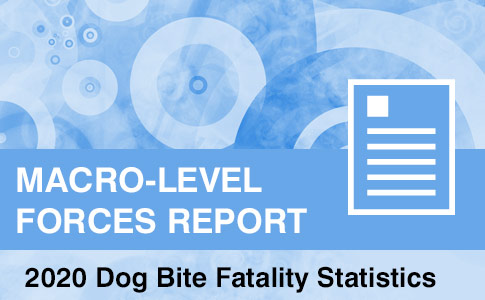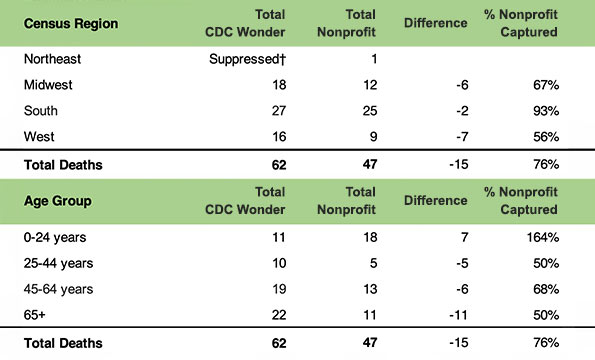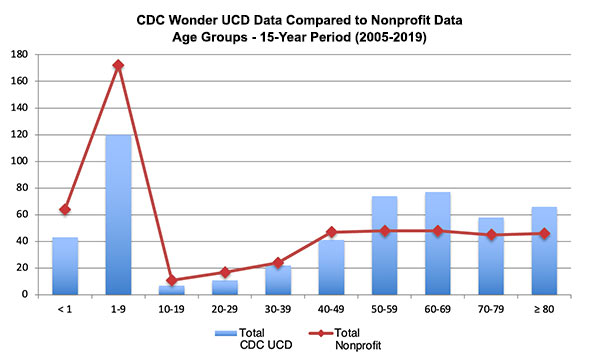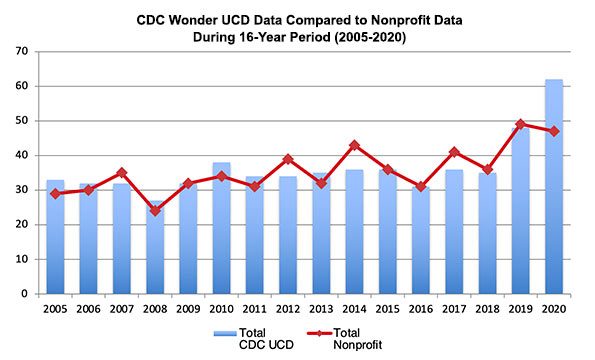Dog Bite Fatalities Surged in 2020; Nonprofit's Capture Rate Declined

DogsBite.org - In June of 2021, we published the discussion notes for 2020 U.S. Dog Bite Fatality Statistics. We cautioned then that media reports during the 2020 Covid year fell by 47%. In response, we sent out 30 FOIAs and uncovered 6 unreported deaths. This, however, did not overcome the macro-level forces caused by Covid. CDC Wonder underlying cause of death (UCD) data shows there were 62 fatal dog attacks in 2020. Our nonprofit only recorded 47 deaths.
62 fatal dog attacks in a single year are the most ever recorded in CDC data. This is a 29% increase from 2019 and a 77% increase from 2018.
Previous to 2020, during the 15-year period of 2005 to 2019, the largest deficit of unreported deaths was 4 each for the years of 2005 and 2010. During the 2020 year of Covid conditions, there was a deficit of 15 unreported deaths. A regional break down of dog bite fatality victims in 2020 shows that the West and Midwest regions had the most unreported cases (13). The South had the lowest number of unreported cases (2) with 93% captured by the media and our nonprofit.
Possible factors causing the disparity of 15 unreported deaths include: stay-at-home orders, one-third of employed began working at home,1 a sharp reduction in media reports and a reduction of media releases from police. The increase in the number of deaths in 2020, may also be linked to Covid conditions. Some cities reported a 2-fold increase in dog bites during 2020. Pediatric hospitals in the US and UK reported a 3-fold increase in rates of ED visits due to dog bites.
The government directed stay-at-home orders and school closures increased child exposure to dogs, as well as adults. According to CDC data, 66% (41 of 62) of the victims in 2020 were ages 45-years and older. Our nonprofit captured 24 of these deaths, 58%. Yet, we already knew the 50 and older age group was underreported by the media. We discussed this disparity in the 2020 discussion notes (Comparing 15 Year Data Sets - DogsBite.org Data and CDC Wonder Data)
Related report:
2020 Macro-Level Forces Report: CDC Dog Bite Fatality Data Compared to Nonprofit

U.S. dog bite fatalities during the 2020 pandemic crisis by Census region and age groups.
Characteristics of Unreported Fatal Dog Attacks (2005 to 2020)
We also discussed the characteristics of unreported fatal dog attacks, based upon 18 unreported deaths that we have uncovered through FOIAs over the last decade. The most likely unreported fatal dog attack from 2005 to 2020 is an adult ≥ 40 years old killed by a single or pair of family pit bulls in an urban area within a state that prohibits or limits breed-specific laws. 83% (15) of cases involved pit bulls, and of that 73% (11 of 15) involved a single or pair of family pit bulls attacking.
78% (14) of the total unreported fatal attacks involved family dogs killing a household member, and 78% of all victims were ≥ 40 years old.
Breaking down the CDC data set by state over the 16-year period also shows that several western states contribute to the most unreported deaths: Arizona, Colorado and Washington (26 deaths total). Arizona had the highest number of unreported deaths (11), which, in part, might be attributed to undetected fatal dog attacks on Indian reservations. Regionally, the West showed the highest number of unreported deaths, 30, followed by the Northeast with 12 unreported deaths.
Related materials:
Macro-Level Forces Report: 2020 Covid Dog Bite Fatalities Compared to CDC Data
Dog Bite Fatalities by State, Region and Age Compared to CDC Data (2005-2020)
Discussion
Macro-level forces simply mean macro social and economic forces beyond our control. Capturing small data numbers (40-50 dog bite fatalities per year) was difficult before Covid struck American soil. This hurdle became much higher during the 2020 Covid year, when the media was extremely focused on the pandemic crisis, followed by the general election. Furthermore, newsrooms cut over 16,000 jobs in 2020, the highest amount on record, and is described as the "2020 bloodbath."
It remains unclear why our nonprofit consistently records more dog bite fatalities in the 0-24 age group than CDC UCD data (275 v. 186 deaths) respectively. This was also true during the 2020 Covid year (18 v. 11 deaths) respectively. Due to miscoding errors and misreporting on death certificates, multiple studies say it is likely that CDC Wonder underreports the total number of deaths from dog attacks.2 But an 89 count difference in this age group appears significant.
It is also significant that three states (populations 5.7 to 7.7 million) comprised 87% (26 of 30) of unreported dog bite fatalities in the West.3
Finally, during the 15-year period of 2005 to 2019, the discrepancy between UCD data (519) and our nonprofit's data (522) was insignificant, even though a portion of our cases involve vicious attacks as a contributing cause of death. In a single year, 2020, the pandemic transformed that by creating a deficit of 15 victims dominated by the ≥ 45 age group. The UCD data over the same 15-year period shows that the majority of unreported fatal attacks also fall into this age group.

15-year period (2005-2019) CDC Wonder data compared to nonprofit data by age group.
Summary
During the 2020 pandemic year, there was a 47% reduction in dog bite fatality media reports, according to our citations. There was a surge in unreported fatal dog attacks, 15 deaths (21 deaths if no FOIAs had been pursued), and a surge in the total number of deaths, from the 5-year average (2015-2019) of 37 deaths to 62, a 68% rise. Victims ≥ 45 years old accounted for the majority of unreported fatal attacks and most of those attacks occurred in the Midwest and West.
Theoretically, there will be another significant deficit in 2021, the second Covid year. Those numbers have not yet been released by CDC.
By examining the characteristics of unreported fatal dog attacks, based upon 18 deaths we uncovered from 2005 to 2020, the most likely unreported fatal attack in our data is an adult ≥ 40 years old killed by a single or pair of family pit bulls. CDC data during this period shows that a large number of adults ≥ 45 years old killed by dogs are unreported in the media (104). Though breed data is unknown, one can assume that a fair number involve pit bulls and family dogs.

16-year period (2005-2020) CDC Wonder data compared to nonprofit data by year.
2Haskell MG, Langley RL, Animal-Encounter Fatalities, United States, 1999-2016: Cause of Death and Misreporting, Public Health Reports, 2020, Vol. 135(6) 831-841.
3U.S. Census Bureau, Population Division
Related articles:
06/01/21: 2020 U.S. Dog Bite Fatality Statistics - Discussion Notes
01/12/21: 2020 Fatal Dog Attack Breed Identification Photographs

For any other consumer product, 62 deaths in one year would be cause for concern on a national level. Of course, it’s complicated by the fact that the CDC feels that breed information related to these deaths is unimportant.
Well written, Farmer Jayne.
The Covid years from 2020 – 2022 could be characterized by the “Packs of Pitbulls” years. Dozens to 100 dogs in general were also removed from homes.
Another key point of the report is that victims ≥ 45 years old seem to be invisible despite some contributing to the American economy for at least 20 years.
I’m sure it relates to “COVID Pups”. Everyone needs a dog to keep them company when working from home.
Now, consider the “inventory” available at shelters at any given time. The vast majority of dogs there are, or are closely related to, Pit Bulls. I estimate many of these dogs had bite histories, also.
Boom. Mic drop.
You nailed it, Animal Uncontrol.
And I’ll bet you money that a lot of the workers from home found that not-so-nice dogs were not such a great deal, even when the shelters were giving them away. I’ll place a second bet and say that a lot of those dogs were taken back to the shelters, where they were put up for adoption. Again.
You nailed it, Animal Uncontrol.
Don’t I always? =)
You sure do!
I’m pretty sure the lack of many of the >45yo deaths is a “hush job” by the surviving family because their own choice of ‘family pet’ caused their deaths. If it was a death of someone unrelated to the dog, then it would more likely have made the news.
Thank you for confirming what I’d suspected. During 2020 and 21 everything disappeared except the election and Covid. I heard that our local shelter adopted all of its dogs. Every where you go there are shiny bright pit bulls pulling their clueless owners around. Two immediate neighbors got new dogs, not pits, thank goodness, but very barky breeds, so I now have 5 barkers on my fence line.
Join the club, Dayna.
I have about the same number of barkers next door, and what I think of those dogs and their owners cannot be printed here on this family blog. Thank goodness they aren’t pits, but they still make quite a racket.
However, there is some good news in the neighborhood. It appears that the pit bull owning sleazeballs across the street are being evicted. I saw an official-looking guy serving papers last week, and the chronological adults looked very unhappy.
Even better, I think they moved the dogs to some other location because I haven’t heard one of their barkathons since the late summer.
That IS good news!
Hopefully, the 2 new comments on the USPS and Animal Control Services will be approved by Dogsbite soon. DBO is understandably protecting the Comments.
Ineffective Animal Control Services thwarting the U.S. Mail
In Ohio–Cincinnati and Cleveland–some neighborhoods are not getting their mail because of dangerous dogs. The USPS is fortunately protecting its route carriers.
One neighbor’s dangerous dog is affecting an entire street or neighborhood.
Animal Control Services have
not been doing their jobs in picking up and impounding/ euthanizing the dogs. Some mail-less neighbors are in their 80’s and do not have cars to pick up their mail at the local post office. They could lose their homes if mortgages and tax payments are not made in time.
This is a severe hardship due to dangerous dogs activism and Animal Control Services failures.
Cincinnati
Watch “No mail delivery for months on local street following postal worker dog attack” on YouTube
Local 13, Sept 23, 2022
Cleveland
USPS stops delivering mail to neighborhood after mailman attacked by dog
KKTV-11, Aria Janel,
Sept 23, 2022
Ohio 3rd in nation for dog attacks on postal workers
Journal-News, Jen Balduf, Jun 3, 2022
New Ohio license plate features Pit Bull, animal activists say it highlights disparity
WKRC, Sept 9, 2022
DBO, see the pitbull advocates’ part in this license plate issuance.
Oops…it’s Local 12 news for Cincinnati. NOT Local 13.
To go directly to the sites, best to just copy the story titles.
First of the 4 stories is on YouTube. The rest on Google.
Indianapolis Care and Control is giving away pitbulls routinely. I wonder when the population is so saturated with them that no one comes to get them. Really nice writeups are being put out.
on the dogs. I wonder who writes them up.. Are they largely copying other writeups?
Same thing is happening here in Tucson. It’s like there’s a three-alarm fire over at animal control. Come rescue these dogs or we’ll have to put them down!
Trust me, animal control, if you backed off your No-Kill policy and started putting those pits down, the animal rights wackos would weep crocodile tears but the rest of us would definitely not.
And, right on cue, here’s the latest Nextdoor post from animal control. Copied and pasted for your enjoyment:
“It’s Monday morning at PACC, and we are starting the week with 522 dogs in the shelter! Can you help us by fostering or adopting today?
“Even just two weeks out of the shelter with a foster can make a world of difference for a dog by helping them come down from the high-stress environment of the shelter and by collecting more information on how are at home. We have SO. MANY. awesome dogs who would benefit from even a short stay in foster!
“Maybe Mocha is your cup of tea? (Or cup of joe?) Mocha came into PACC in FEBRUARY with her litter of NINE puppies! Her puppies were quickly adopted, but this sweet mama still waits at the shelter for her chance.”
BTW, Mocha is a pit bull.
Oh, another pitiful pound puppy story from Tucson. This one’s courtesy of KVOA, a TV station. Excerpt:
“TUCSON (KVOA) – If you are looking for a new best friend, you just might find it at the Pima Animal Care Center.
“The center located in northwest Tucson is in urgent need of adopters and fosters right now.
“Part of the reason is multiple intakes of large-breed dogs from overwhelmed caregivers.”
Wonder why those caregivers were feeling overwhelmed by their large-breed dogs. The story doesn’t say.
Quiet, those responding to Tucson KVOA’s PPP story probably have such overwhelming love for “puppers,” AKA 5-yr-old pitbulls, that they know they will be that unique person to show that love wins out over hundreds of years of breeding.
They can use any excuse they want for increased deaths by dogs. But it has nothing to do with people being home more with their dogs or any other issue except they were pushing the pits out of the door to anyone that wanted a dog and lying to them about breed and safety
Bravo to you for making this known! Little by little we who care and are brave as well as willing to take the time to alert others and with no self gain is what will make our world a safer place.
And to Pam Rock rest in peace faithful deliverer of our daily mail.
I am using the voting time to make strong laws in our county say for instance our Sheriff is running for Judge and I as a voter called with the Ordinance number of Batesville Arkansas which has a very strong law in regard to pit bulls. Basically, if he wants my vote then step up to the plate and protect us.
Deep shame to Putnam County Florida
Keep up the good fight Nunzia!